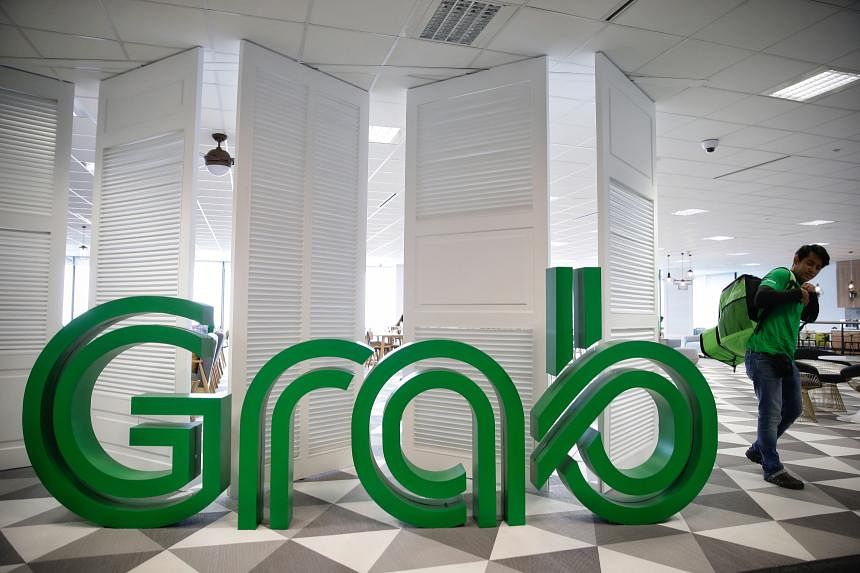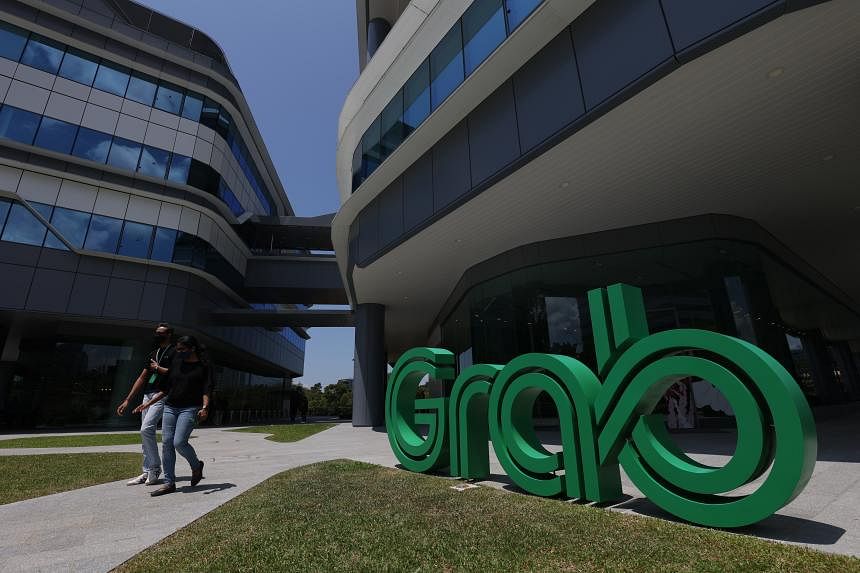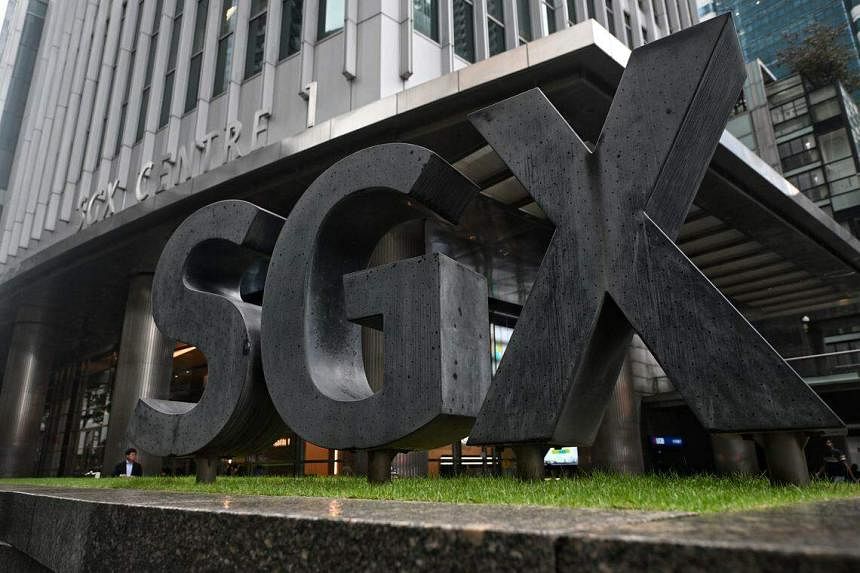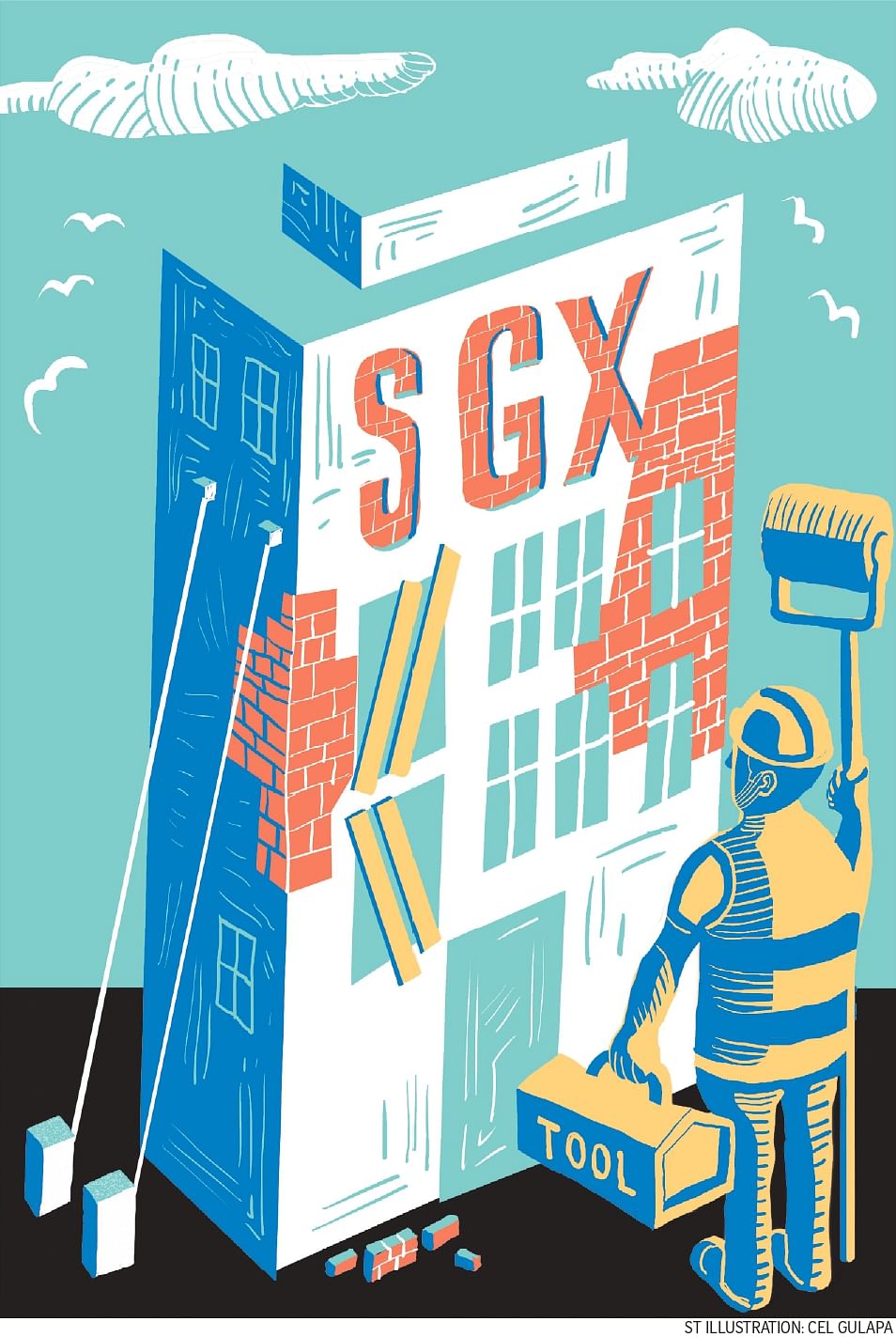Can Singapore revive the stock market from its sick bed?
Kang Wan Chern
Assistant Business Editor
The SGX has successfully listed some of the world’s biggest Reits and courted three special purpose acquisition companies. PHOTO: ST FILE
UPDATED
APR 1, 2023
SINGAPORE – For years, American investor Jim Rogers has been looking to buy and hold Singapore stocks that are cheap, unique and possess exciting growth prospects. The pickings have been lean.
Mr Rogers, who is known for being bullish about commodities and China, has identified just a handful of local companies that fit the bill, including Singapore Airlines (SIA), air cargo handler Sats and coal miner Geo Energy Group, where he is a director.
Mr Rogers, who has lived here since 2007, has cast his eye over other stocks such as the real estate investment trusts (Reits) the Singapore Exchange (SGX) is known for, but notes: “There are too many of them. I am looking for something that is unique.
“There are many other good and well-managed companies listed in Singapore that should be on investors’ radars, but they just don’t do well as stocks.”
Mr Rogers cites SIA: “The airline is among the best in the world yet its share price has been going down for the past 15 years.
“It’s just not a good stock and I can’t figure out why.”
SIA traded at just under $15 a piece in 2007 but is now around $5.73.
One culprit is declining liquidity on the SGX.
A liquid stock market attracts more investors as they can easily buy and sell shares at prices they are comfortable with. This, in turn, increases trading and supports stock valuations, which attracts more companies to list.
This is important for Singapore, which is growing as a financial hub.
Mr Tham Tuck Seng, capital markets leader at PwC Singapore, says: “If Singapore wants to be a forward-looking digital economy, it must have a robust platform for innovative firms to raise capital.”
The SGX has successfully listed some of the world’s biggest Reits, courted three special purpose acquisition companies and brought the secondary listings of Chinese electric vehicle maker Nio and the Philippines’ largest brandy maker Emperador to the local market, among others.
Yet, liquidity levels have not risen.
The benchmark Singapore Straits Times Index (STI),
now at around 3,260 points, is near the same level it was 10 years ago, and lower than its peak at just over 3,700 points in October 2007.
In contrast, the United States’ S&P500 index has more than doubled over the same period, while India’s Sensex index has more than tripled since 2007.
A flat or declining index is not attractive to investors, as it suggests that most are not making money from it. It also hits trading volumes and liquidity.
From the financial year (FY) 2015 to FY2021, daily average traded value on the SGX fluctuated between $1 billion and $1.4 billion, and fell under $1.3 billion in FY2022, according to SGX data.
The number of initial public offerings (IPOs) – where a company raises capital by offering its shares to the public for the first time – on the SGX has fallen over the years, with 12 companies listing in 2022, excluding secondary listings, versus 20 in 2017. Just one company has done an IPO so far in 2023 – YKGI, which owns the Yew Kee duck rice chain.
Singapore online property solutions company
Ohmyhome made its debut on the Nasdaq on March 22, opting, like its rival PropertyGuru, to list in the US “for better valuations”, its founders told The Straits Times.
Other Singapore tech firms such as Grab, Sea and Razer have also taken their IPOs elsewhere.
More companies are leaving the SGX than joining it. In 2022, 36 companies left the bourse, compared with 22 in 2021 and 39 in 2020. In 2023,
Boustead Projects, Golden Energy and Resources and
GK Goh are among those that have received privatisation offers.
Even a track record of profitability does not attract or excite investors. This leaves issuers frustrated and some seek to go private. Singapore Medical Group, which delisted in 2022, said a lack of interest from investors had hampered it from raising funds.
Mr S. Nallakaruppan, president of The Society of Remisiers (Singapore), notes: “Companies go public either because they can get much better valuations from the market, or to raise additional capital.
“If neither condition is met, it is better for them to stay private or list elsewhere.”
To be fair, stock markets worldwide have been volatile, with many opting for other investments with more stable returns.
Mr Nasser Ismail, global head of equity capital markets at the SGX Group, points out that stock trading has fallen globally over the past year as interest rates rise. The number of IPOs has dwindled even in the US.
EY data shows that global IPO volumes fell 45 per cent in 2022 compared with 2021, with proceeds raised down by 60 per cent year on year. The downward trend has continued in 2023, Bloomberg data showed.
But trading on the SGX is still below par. ST examines four factors behind this.
Lack of players and variety
The SGX, which is widely seen as an exchange dominated by Reits and banks, needs a larger and more diversified mix of active investors and issuers to make it more vibrant and liquid.
“The reason there is low daily liquidity is that investors here are more conservative and many buy blue-chip shares like SIA, Singtel or the banks for their dividends and stability, and hold them for the long term,” says Mr Gavin Chia, managing director of online broker moomoo Singapore.
Mr Jason Tan, portfolio manager at local brokerage Phillip Securities, said many of his clients are moving money back into the Singapore stock market after dabbling in US stocks and cryptocurrencies, and many are investing in Reits.
“Reits have always been a popular choice among Singapore investors due the constant dividends and common belief that properties will never go wrong as an investment in Singapore,” he said.
Some say big institutional investors like state investment fund Temasek should be more active in the local market.
Singapore companies, including listed blue-chip firms like DBS, Singtel and Keppel Corp, accounted for around 27 per cent of Temasek’s investment portfolio by underlying assets as at March 31, 2022, a spokesman said.
Temasek last participated in an SGX IPO in 2020,
when it invested in Nanofilm. It bought shares in AEM Holdings in 2021 through a private placement, which is a sale of shares to pre-selected investors rather than publicly on the open market.
It also took part in several rounds of rights issues by portfolio companies such as SIA, Sats, commodities trader Olam International and shipyard Sembcorp Marine.
In a rights issue exercise, a company offers its existing shareholders the chance to buy additional shares at a discounted price.
Temasek’s spokesman says the fund invests in companies it expects will benefit from four trends – digitisation, sustainable living, future of consumption and longer lifespans.
The local stock market needs more issuers from other industries, like technology, to attract a wider mix of investors.
Mr Nasser says few Singapore tech companies are mature enough to go public for now: “The critical mass of growth companies is not there yet, but their supply will come with time. As the region matures, we expect some of them to list here.”
He cites tech companies such as Venture Corp, AEM and Silverlake Axis that trade well on the SGX, noting: “We believe it is a matter of time before other technology companies here become familiar names to investors. When that happens, trading of their stocks will improve.”
Mr Nasser adds that Singapore’s Reit regime took two decades to build up to the 42 firms now listed: “People need time to understand and observe the sector.
“In the meantime, we have to look beyond Singapore to draw others in the region to list here.”
The SGX is receiving support from the Government and Temasek on this front, with the launch of a co-investment fund starting at $1.5 billion to help high-growth, digital economy companies list in Singapore.
Since September 2021, the Anchor Fund @ 65 has invested around 25 per cent of its capital in used car platform Carsome, shopping and rewards app Shopback, and entertainment firm Neon.
The Monetary Authority of Singapore (MAS) has raised the cap for a grant to better support the listings of unicorn companies – defined as unlisted start-ups valued in excess of US$1 billion (S$1.3 billion) – in Singapore. Since its inception in 2019, the grant has supported 37 listings, 27 of which were on the Catalist board.
Need for more investor engagement
Catalist companies currently see lower trading volumes than their Mainboard peers and more should be done to get investors interested in them.
ST understands that while there are around 700 to 800 companies listed on the SGX, the bulk of trading is done mainly on the Reits, three local banks and some component stocks on the STI. “This, when many other SGX-listed companies offer decent dividend yields of 3 per cent or more and trade below their valuations,” Mr Nallakaruppan says.
Mr Nasser says that firms should do more to raise their profiles among investors: “Companies should treat their IPOs as a next stage of growth and spend time and resources to engage shareholders and investors so they would continue to invest in them.”
Veteran investor Ang Hao Yao agrees. “All companies should aim to have an investor relations (IR) function to help them explain how their products are improving investors’ lives or bringing Singapore as a country forward”.
Mr Ang, who for the past 30 years has invested mainly in smaller-cap firms, including those on Catalist, adds that these companies should also voluntarily report their financials on a quarterly basis to keep investors up to date.
The Straits Trading Company has been doing just that.
The conglomerate launched a shareholders’ club in 2021, giving members access to management and private events. Accredited investors also enjoy opportunities to invest in novel real estate tokenisation projects.
Since starting the club, the number of shareholders in Straits Trading has increased by approximately 50 per cent, from 4,000 to around 6,000, says Mr Eric Teng, chief executive of Straits Development, the firm’s property business.
But many other firms need more help to engage. The SGX runs programmes for shareholders to gain face time with the management of listed companies, but some observers said it can provide better customer service to ensure issuers’ needs are met after they list.
Some brokers and sponsors are lending a hand. SAC Capital, which provides sponsor support for Catalist companies, has started an equities research arm to help investors uncover “investment gems” not often on the radar with the help of social media, says head of equities research Matthias Chan.
moomoo Singapore is using its online reach to raise the profiles of home-grown firms such as artist management company NoonTalk Media and wireless Internet solutions provider iWow Technology, which both listed on Catalist in 2022.
Mr Chia says many investors, especially the younger ones, do not know about the made-in-Singapore companies listed here. “If they are not aware you exist or are listed, how will they invest in you?”
There is little independent research available on smaller-cap stocks, which are more affordable, said Securities Investors Association Singapore (Sias) president David Gerald. A scheme to provide more such research was launched in 2004 but called off after three years.
Mr Gerald adds that most existing research is now done on large-cap stocks by analysts at broking firms, but many retail investors do not have access to the information.
This should soon improve. The MAS said 13 research houses have taken advantage of a grant to widen the research coverage of SGX-listed stocks. As at December 2022, the firms had hired 34 research analysts who generated more than 800 reports on 132 SGX-listed companies – about 20 per cent of the total listings.
Tiger Brokers has started issuing regular reports on specific industries as well as macroeconomic events for its clients. Mr Edmund Chan, a director from the online broker, says this has encouraged more to start investing.
Former remisier Tng Kim Bock adds that the SGX should increase the range of pricing data available to the market and make it free of charge, as this helps investors trade more efficiently.
Onerous conditions, little recourse
The SGX should find a better balance between running a tight ship and subjecting firms to overly prohibitive regulations.
A number of IR firms told ST that some Catalist companies are at times reluctant to take corporate actions, such as rights issues and mergers and acquisitions, due to the SGX’s compliance and disclosure requirements. These include Exchange queries each time their share prices see sudden movements, for example, which they see as being bad for their reputations.
The IR firms added that some sponsors can also be overly restrictive. Sponsors are authorised by the SGX to evaluate companies’ suitability to list and assist them in meeting their ongoing regulatory and disclosure requirements, among others.
Mr Nallakaruppan and Mr Tng agree that regulations such as the minimum trading price (MTP) rule, announced in 2016, have suffocated trading.
Under that rule, which required Mainboard companies to maintain an average share price of at least 20 cents for six months to curb speculation, many companies were forced to merge their shares to prop up the price, resulting in fewer shares available, or move to Catalist. Those who failed to do so were put on a watchlist.
Although the MTP rule was abolished in 2020, the damage has been done. Many investors who left the market because of the rule never came back.
Regulations became tighter in 2013, after the SGX suspended the shares of penny stocks Blumont Group, Asiasons Capital and LionGold Corp, collectively known as BAL. This came after investigations revealed that their share prices had been artificially inflated.
All three stocks later crashed, erasing up to $8 billion in combined market value.
The BAL scandal was followed by the
collapse of heavily indebted commodities trader Noble Group in 2018 after it drew flak for irregular accounting practices and later became a target for short sellers.
The SGX responded by enhancing trading safeguards and disclosure obligations and introduced more rigorous requirements for IPOs.
The Singapore Exchange Regulation (SGX RegCo) was also set up to supervise issuers and trading activities on the SGX. It was armed with investigative and direct enforcement powers.
While the regulations were meant to promote a more transparent and efficient market, they have nevertheless frustrated some issuers.
“The SGX RegCo should relax. Not every firm is Noble and not every trader is John Soh,” said one observer, referring to the mastermind behind the BAL scandal.
SGX’s Mr Nasser said: “We are in the business of trust and there is no compromise on this. We want people to be assured that the share price they are getting in the stock market is real. If we lose this trust then we have lost the market.”
But while action is taken against errant firms, there is little recourse for retail investors who suffered hefty losses from BAL, Noble and other stocks that have collapsed. Many other companies are also suspended, and those who invested in them are unable to get their money back.
“It is critical to set up an ombudsman office to hear investor grievances and seek recourse for aggrieved investors,” Mr Nallakaruppan says.
“We need to rebuild much-needed investor confidence in the stock market. This is one of the main reasons why liquidity has declined.”
Should SGX invest more in the equities business?
Apart from being a regulator, the SGX is itself a listed company responsible for delivering profits to its shareholders.
In recent years, it has channelled resources to expanding its more lucrative commodities and currency derivatives business while the equities business has weakened.
SGX Group reported a 7 per cent year-on-year increase in adjusted net profit to $236.8 million for the first half of its FY ending June 30, 2023. Total revenue increased 10 per cent to $571.4 million in the same period. This was mainly driven by the currencies and commodities derivatives business, which rose by 40 per cent to $150 million over the period.
In contrast, revenue from the equities business, excluding equities derivatives like exchange traded funds (ETFs), declined by 10 per cent to $171.2 million. Daily average traded value declined 7 per cent to $1.1 billion.
With the SGX deriving a growing portion of its earnings from derivatives, some observers said the bourse may not have sufficient incentive to invest further into its equities business for now.
In a March 14 post-results report on the SGX, RHB Invest analyst Shekar Jaiswal wrote that the SGX’s equities business, excluding equities derivatives, will continue to be weak amid decelerating global growth.
He added that delays in major IPOs amid low market valuation would block any meaningful growth in daily average trading volumes in FY2023.
“The SGX derives a growing portion of revenue from derivatives and it will go where the money is,” says Mr Tham of PwC.
But he says the equities business is still an important pillar for the SGX’s growth: “Singapore is a financial hub and we need the SGX to continue engaging with IPO aspirants and promoting us as a place for companies to list and raise funds.”
The SGX has several factors going for it. More global funds are flowing into Singapore via family offices and other asset managers, said Mr Tham. More international firms are also showing interest to list on the SGX and use it as a platform to expand in the region.
Firms that were formerly listed on the SGX could also seek to relist in the years to come. In February, contract manufacturer Hi-P International told The Business Times that it might relist here in 2024 or 2025 to fuel its expansion.
Mr Nasser says that the SGX is still an attractive exchange with credible investors and regulatory stability.
Home-grown companies that list here are more likely to be appreciated by local investors than in bigger and busier bourses in the US or Hong Kong.
“We are still attaining scale but we are already so much more than just an exchange for real estate companies and banks,” he notes.
That may be so, but convincing stakeholders, including investors like Mr Rogers, will take a lot more doing.









